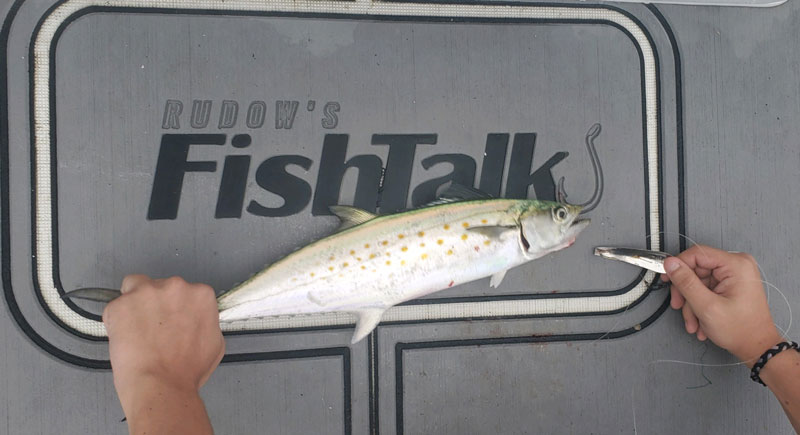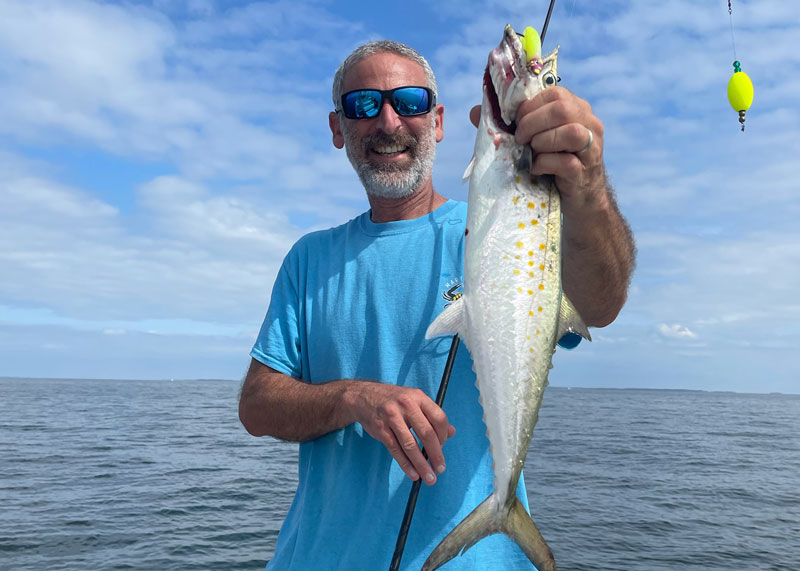We’ve all been there before: there are little bluefish or stripers busting on bait, and suddenly out of the corner of your eye you see a pelagic-looking creature shoot out of the water, arc gracefully through the air, and then disappear forever. The Spanish mackerel are here! You cast, and cast, and cast in every direction. Or maybe you troll, and troll, and troll in circles. Either way, you catch a pile of dink rock and bluefish but never manage to slide the net under that polka-dotted Spaniard.

Don’t feel bad — like we said at the start, we’ve all been there. And it can be frustratingly difficult to hook up with a Spanish mack at times, especially when other species are churning water right alongside them. What to do? For starters, don’t give up because sooner or later you’ll get one. And hopefully, these 10 mackerel-catching tips will help make that happen.
- Speed matters. We won’t dwell on this because most Bay anglers already know to reel as fast as possible or kick up the trolling speed by several mph to get mackerel biting. But when you catch yourself lazily turning the crank or glance down and notice you’re only doing six knots, you don’t have to wonder what the problem is — it’s insufficient speed.
- Get away from the pack… and we don’t mean the pack of boats. We mean the fish. Remember all those little rock and blues? If they snap up your lure every five seconds the mackerel won’t even have a chance to eat your offering. Instead of casting into the middle of a frenzy or trolling right through it, work the outskirts of the school.
- If you know the fish are there and you’re not getting bites, consider dropping leader size. Spanish mackerel have excellent eyesight, and using a fluorocarbon leader of 20- or even 15-pound test will definitely result in more bites than using 30.
- When casting, give your lures some sink-time after the cast. Remember, trollers are pulling planers. We all know how effective those are, and we also know that those planers keep the lures well beneath the surface. So allow your lure enough time to sink to 15 or 20 feet deep before you start cranking on the reel.
- When casting lures and you see a mackerel gray-hounding, cast a solid 50 feet in front of it. Cast 20 feet in front and by the time the lure smacks down the mackerel will already be past that point. Remember, those fish are moving F-A-S-T!
- Hold your rod tip low as you crank. Since you’re trying to crank as fast as you can — it’s literally impossible to retrieve too quickly for Spanish mackerel, even with a modern high-speed reel — keeping your tip low will help prevent your lure from skipping out of the water late in the retrieve. It will also make hook-sets automatic when the fish strikes.
- When trolling, switch all of your cheap barrel swivels for genuine ball-bearing swivels. Yes, these cost an arm and a leg, but they are far more effective at preventing line twist, and thus tangles.
- Keep your larger planers closer to the boat, and make their leaders short enough that if the planer trips and rises to the surface the spoon is nowhere near your lines running farther aft. Again, this helps reduce tangle disasters.
- If you haven’t already, check out The Ideal Spanish Mackerel Trolling Speed. Walt, the author, has nailed down the way to find the ideal trolling speed for mackerel in different conditions with his formula. Commit it to memory and you’ll never have to guess at the most effective trolling speed again.
- When you're fishing for mackerel from a pier or shore, most of the time you’ll need to make extremely long casts one after the next. A heavy spoon will fly far, but also sinks like a rock and can wear you out fast. Instead, try using a “water bobber,” a clear, hollow bobber you can fill with water. That provides the weight you need to extend your casting distance but still allows for flinging a smaller, lighter spoon.

BONUS TIP: Consider switching to popping cork rigs when casting for Spanish mackerel. I made the switch three or so years ago, and found that they often out-catch traditional spoons by a two-to-one margin. But don’t use the southern-style chug-pause-chug retrieve. Instead, keep the rig moving full-tilt at all times so the cork chugs across the surface of the water nonstop… until, BAM!